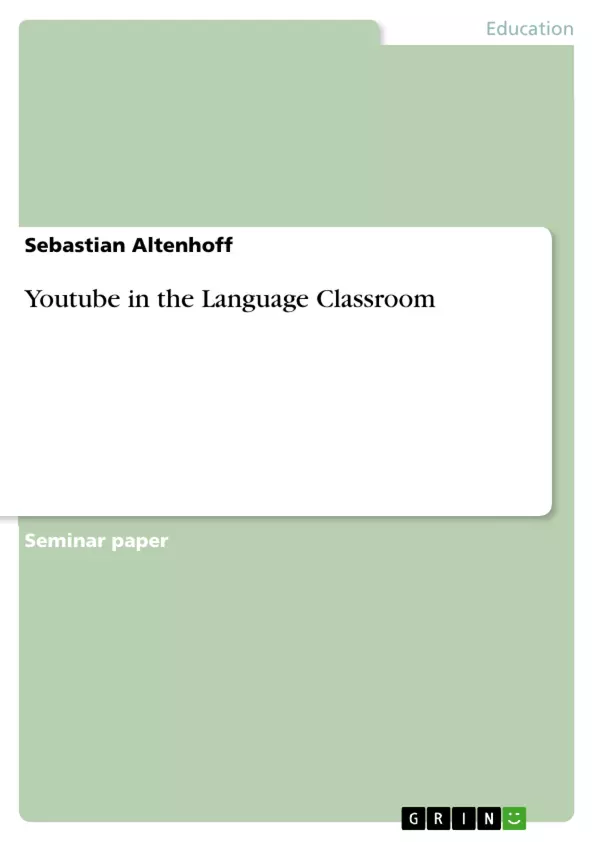According to Ellis, learning a language means making use of the language (in Rüschoff/Wolff: 1999, 54). This not only implies the claim of free, spontaneous communication but also of dealing with and of experiencing the target language as such.
The claim of experiencing the target language in the language classroom, leads to a growing interest in the quality of the materials used. According to Wolff (1998), any kind of learning – no matter whether verbal or non-verbal – has to be embedded in a rich learning environment that has not been reduced concerning its complexity. Authenticity is thus one of the main criteria in order to evaluate the quality of materials. This criterion applies to all materials – such as literature – that have not been changed for the purpose of teaching and learning, of course. In this thesis, however, using authentic video in the language classroom will be considered and analysed according to its didactic benefits.
Integrating video in the language classroom does not necessarily mean having to watch and to analyse a whole film of ninety minutes. Thanks to Web 2.0 applications such as YouTube, the accessibility of short video clips, advertisements or film excerpts has become very simple. Because of the growing popularity of this webpage and of integrating Web 2.0 applications in the learning environments in general, my entire analysis will relate to videos taken from YouTube.
This thesis aims to provide both a theoretical (part I) and a practical investigation (part II) of the topic: in order to create a framework for analysis, I will first of all give a short overview of the didactic benefits of integrating authentic video in the language classroom in general. This survey is followed by a short description of the basic ideas of YouTube – such as free accessibility or the possibility to contribute –, in order to work out the advantages these YouTube-specific features additionally offer.
The practical part (part II) aims to put theory into practice: I will describe and analyse a lesson that was originally planned for and executed in several tutorials for first semester EFL students. Although YouTube was part of a language course at university, this lesson could as well be adapted for the Oberstufe and is hence an appropriate example within the context of this topic. In the lesson the sketch served as an introduction to the topic Phonetics & Phonology.
The thesis closes with a summary of the main conclusions of part I and II.
Inhaltsverzeichnis (Table of Contents)
- Introduction
- Using video in the language classroom - general considerations
- Why use authentic video at all?
- The medium film in the English curriculum
- Some applications and activities of video in the language classroom
- Authentic video sources and features
- YouTube - - or: "Broadcast Yourself!"
- ITube, YouTube, WeTube - what actually is YouTube?
- Characteristic features and functions of YouTube
- Main points of criticism
- Copyright
- Anonymity
- Using YouTube in the language classroom
- Equipment
- Putting theory into practice: the Two Ronnies
- General information
- Description of the lesson
- Analysis of the lesson
- Conclusion
- Bibliography
- Appendix
- Transcript of the Four Candles sketch
Zielsetzung und Themenschwerpunkte (Objectives and Key Themes)
This thesis investigates the didactic benefits of using authentic video in the English language classroom, focusing specifically on the potential of YouTube. It aims to provide both a theoretical and practical analysis of the topic, creating a framework for understanding the advantages of authentic video in language learning. The key themes explored are:- The importance of authentic materials in language learning
- The benefits of integrating video in the language classroom
- The unique features and potential of YouTube for language learning
- The practical application of YouTube in a language classroom setting
- The analysis of a specific lesson using a YouTube video
Zusammenfassung der Kapitel (Chapter Summaries)
- Introduction: This chapter introduces the thesis, emphasizing the importance of experiencing the target language in the language classroom and the role of authentic materials in fostering this experience. It highlights the growing accessibility and popularity of authentic video, particularly through online platforms like YouTube.
- Using video in the language classroom – general considerations: This chapter provides a general overview of the didactic benefits of using video in language learning, focusing on the advantages of authentic video compared to traditional teaching materials. It discusses the accessibility and motivational aspects of video, emphasizing its potential to engage learners and enhance language acquisition.
- YouTube - - or: "Broadcast Yourself!": This chapter introduces YouTube and explores its features and functions, highlighting its unique potential for language learning. It also discusses critical points like copyright and anonymity, acknowledging potential challenges associated with the platform. Finally, it explores the specific applications and strategies for integrating YouTube in the language classroom.
- Putting theory into practice: the Two Ronnies: This chapter presents a detailed analysis of a practical lesson using a YouTube video from the "Two Ronnies" sketch show. It describes the lesson's objectives, activities, and student engagement, demonstrating how YouTube can be used as a valuable tool for introducing and exploring different linguistic concepts in a motivating and engaging way.
Schlüsselwörter (Keywords)
This thesis explores the integration of authentic video, specifically YouTube, in the English language classroom. Key themes include the importance of authentic materials, the benefits of video for language learning, and the unique features and potential of YouTube for educational purposes. The thesis analyzes the practical application of YouTube in a lesson focusing on phonetics and phonology, highlighting its potential for motivating and engaging learners.- Quote paper
- Sebastian Altenhoff (Author), 2009, Youtube in the Language Classroom, Munich, GRIN Verlag, https://www.grin.com/document/166764



